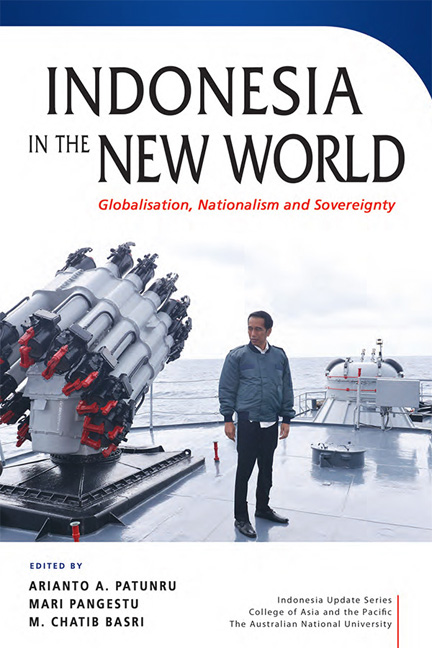Book contents
- Frontmatter
- Contents
- Tables
- Figures
- Contributor
- Acknowledgments
- Glossary
- 1 Challenges for Indonesia in the new world
- PART 1 Globalisation, Nationalism and Sovereignty: the Indonesian Experience
- PART 2 Nationalism in Practice
- PART 3 Impact of and Response to Globalisation
- PART 4 The Human Face of Globalisation
- 11 Globalisation and labour: the Indonesian experience
- 12 Restoring the rights of Indonesian migrant workers through the Village of Care (Desbumi) program
- 13 Globalisation, the role of the state and the rule of law: human trafficking in eastern Indonesia
- PART 5 Navigating The New Globalisation
- Index
- INDONESIA UPDATE SERIES
13 - Globalisation, the role of the state and the rule of law: human trafficking in eastern Indonesia
from PART 4 - The Human Face of Globalisation
Published online by Cambridge University Press: 08 June 2019
- Frontmatter
- Contents
- Tables
- Figures
- Contributor
- Acknowledgments
- Glossary
- 1 Challenges for Indonesia in the new world
- PART 1 Globalisation, Nationalism and Sovereignty: the Indonesian Experience
- PART 2 Nationalism in Practice
- PART 3 Impact of and Response to Globalisation
- PART 4 The Human Face of Globalisation
- 11 Globalisation and labour: the Indonesian experience
- 12 Restoring the rights of Indonesian migrant workers through the Village of Care (Desbumi) program
- 13 Globalisation, the role of the state and the rule of law: human trafficking in eastern Indonesia
- PART 5 Navigating The New Globalisation
- Index
- INDONESIA UPDATE SERIES
Summary
HUMAN TRAFFICKING AND GLOBALISATION
Human trafficking is a global phenomenon. Like flows of financial resources and traded goods and commodities, flows of people in the form of international migration are rising, thanks in part to better transporta¬tion and communications technology. Labour migration from rural or remote areas to the cities or to major centres of production is part of this phenomenon. For poor, rural workers, labour migration can offer a path out of poverty. But for those who are deceived into working in other coun-tries, it may represent the worst form of labour exploitation and hence is one of the dark sides of globalisation (Jones et al. 2007: 108).
Globalisation can provide a road back to slavery if the movement of labour is not regulated, and if those regulations are not enforced. One form of exploitation of migrant labour is human trafficking. In Indo-nesia, human trafficking needs to be addressed not only through regional mechanisms such as ASEAN, but also though strategies to reduce social exclusion—because the most commonly targeted victims are the poor and those living on the margins of society.
Law enforcement agencies have not been able to keep up with the criminal networks that have arisen to take advantage of the opportuni¬ties for human trafficking offered by globalisation. Castells (2010: 172) says that ‘global crime, the networking of powerful criminal organiza¬tions, and their associates, in shared activities throughout the planet, is a new phenomenon that profoundly affects international and national economies, politics, security, and, ultimately, societies at large’. The global criminal networks base their management and production functions in low-risk places where they can control the formal institutions of state (Castells 2010: 173). Surprisingly, this is the picture in certain parts of Indonesia today.
This chapter analyses the impact of human trafficking based on find¬ings from East Nusa Tenggara, one of the poorest provinces in Indonesia. I argue that severe disparities between regions in Indonesia and lack of access to justice in peripheral areas have allowed human trafficking to take hold. Access is understood as ‘the match between societal commitment and institutional capacity to deliver rights and services and people's capac¬ity to benefit from those rights and services’ (De Jong and Rizvi 2008: 4).
- Type
- Chapter
- Information
- Indonesia in the New WorldGlobalisation, Nationalism and Sovereignty, pp. 243 - 264Publisher: ISEAS–Yusof Ishak InstitutePrint publication year: 2018

